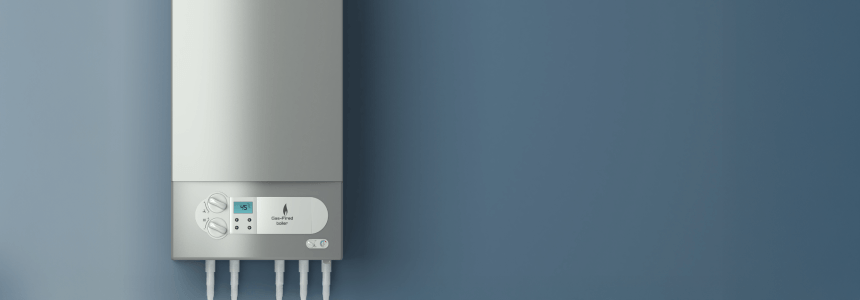
Contemplating coverage?
Subscribe to receive our emails & get
$200 OFF!
Have questions?
Call us: (833) 544-8273


Written By Rachel Cherem
You can get a surprising amount of mileage out of your furnace at home, but every appliance needs to be replaced eventually. We’ll share some maintenance tips to help you maximize the lifespan of your furnace and review the signs that suggest you’re finally due for a replacement.
Just how long does a furnace last? The typical range is between 15 and 30 years, though of course there are outliers. A particularly poorly maintained or improperly installed furnace might fail after only 10 years, and one that is meticulously cared for may push 35 or 40 years.
You can get a more precise estimate of your furnace’s predicted lifespan by considering what type of furnace you own and the factors that play into its health. More on this below.
Yes, some types of furnaces last longer than others. So how long does a gas furnace last relative to an electric or oil-burning furnace? Generally, furnaces that use gas and oil fail sooner than electric furnaces and boilers. Refer to the table for a more detailed comparison.
Furnace Type | Average Lifespan | Pros | Cons |
Gas furnace | 15–20 years | Fast and efficient heating
Lower fuel costs | Somewhat shorter lifespan
Usually more expensive to install |
Oil furnace | 15–25 years | Powerful and reliable heating | Lower efficiency
Higher and more volatile fuel costs |
Electric furnace | 20–30 years | Long lifespan
Inexpensive installation | Higher long-term operating costs |
Boiler | 15–30 years | Long lifespan
High efficiency | Often requires complex maintenance
High installation costs |
Many variables can affect a furnace’s longevity beyond its fuel source. Additional factors include the following:
If your furnace is getting up there in age, be mindful of signs that suggest a breakdown is imminent. Warning signs include:
The presence of these symptoms doesn’t guarantee the need for an immediate replacement. You may be able to troubleshoot your furnace to isolate the cause of the problem, then remedy the issue with a quick DIY fix.
Preventive maintenance is critical to getting as many years as possible out of your furnace. Schedule a professional service checkup for your furnace at least once per year, ideally before the cold weather sets it. You should have your broader HVAC system professionally serviced twice per year.
A thorough checkup may involve the following tasks:
A thorough maintenance checklist serves two important purposes: it keeps your equipment in good condition so it functions optimally, and it helps you identify potential problems early on so that you can resolve them before they get out of hand.
Even with exceptional maintenance, all appliances need to be replaced eventually. If and when your furnace does break down, you can protect yourself from out-of-pocket costs by leveraging your home warranty coverage. Liberty Home Guard’s comprehensive systems coverage can support your furnace and broader HVAC system. Find your plan by calling (833)-545-3434.
There’s a reason Liberty Home Guard was rated the #1 Home Warranty Service by U.S. News and World Report for 2021, 2022, 2023, and 2024. Check out our services.
Learn MoreA major home heating appliance will usually last a minimum of 15 years. If you keep up with maintenance and the conditions are favorable, a heater or furnace could last for 30 years or more
No, gas furnaces do not usually last longer than electric furnaces. At the high end, gas furnaces may last 20 or 25 years, but electric furnaces may keep working for 30 years or more.
Of course, more plays into the longevity of an appliance than just its fuel source. A well-maintained gas furnace will likely outlast a neglected electric one.
Some simple practices can help you boost your furnace’s longevity. Replace the air filter every 1 to 3 months and have your furnace professionally serviced at least once per year. Keep the thermostat setting mostly steady so the furnace doesn’t need to work too hard to bring the home up to your desired temperature. Take steps to make your home more energy efficient to limit heat loss and reduce demand on your furnace.
Signs that suggest your furnace is at the end of its life include poor heating, strange noises, and increasingly frequent malfunctions and breakdowns. Also keep an eye out for rising energy bills, which suggest decreasing furnace efficiency.
Electrical problems, such as tripped breakers, could suggest that the furnace sequencer or other components are failing, and it might be worth investing in a new appliance instead of simply replacing component parts.
When deciding between repairing and replacing your furnace, consider the cost of repair, the age of the furnace, and the likelihood of additional repairs in the near future. If your furnace is within a few years of its average life expectancy, a replacement may be the better choice.
You’re more likely to work a furnace longer and harder in colder climates, so a furnace’s lifespan might average a little longer in places with milder winters. Humidity can also play a role, as humid environments can facilitate corrosion.
Stay Ahead of Potential
Home Mishaps!
Subscribe to our Liberty Home Guard Newsletter and gain access to exclusive content that ensures your peace of mind.